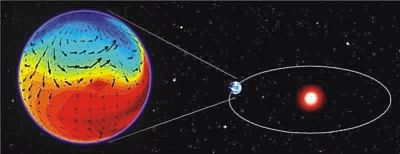First habitable Exoplanet?

It's been forever that mankind has wondered whether our beloved blue planet, the Earth, is the only one in the entire Universe that supports life of various kinds. This uniqueness of Earth has been inspirational in the quest of finding a cosmic neighbour and understanding the strong possibility of extra-terrestrial life-forms. Many researches are dedicated to shed some light on this aspect and it seems scientists from the Institut Pierre Simon Laplace (CNRS, UPMC, ENS Paris, Ecole Polytechnique) in Paris, France are decisively considering Gliese 581d as the first confirmed exoplanet (planet outside of our solar system) that could support Earth-like life-forms.
Located 20.3 light years away from the Sun, residing in the constellation of Libra, Gliese 581 is a red dwarf star that is believed to be supporting a system comprised of six (6) planets. Gliese 581 has been repeatedly associated with housing Earth-like planets from time to time by astronomers. And Gliese 581d is the 3rd planet of that famed solar system, the 5th in the order from the star, now believed to be residing in the habitable zone (the right distance from a parent star where a planet, much like the Earth, can maintain liquid water on surface and thus harbour life). Initially, it was perceived that Gliese 581d was too cold to sustain life, but as the research went on it proved to be a strong candidate for an exosolar Earth-like planet. Published in the Astrophysical Journal Letters, researchers Robin Wordsworth, Francois Forget and co-workers, judging by the weather patterns, strongly argue that Gliese 581d might just be the Earth-like planet with extra-terrestrial life forms.
It is understood that Gliese 581d is a rocky planet with a mass at least seven (7) times that of Earth and about twice its size and receives less than a third of the solar energy than that of our blue planet. And also believed to be tidally locked with a permanent day and night side. Initially, because of this, it was thought the planet was, both, too cold and too hot to sustain life. But to test this idea in more in depth, a team of European scientists developed a computer model, which is capable of more accurately determining the climate of a exoplanet by stimulating the planet's atmosphere and surface in three dimensions, very much like those that are used to study the climate change here on Earth.
The study found out that, having dense carbon dioxide, which is a likely scenario in a large planet, the climate of Gliese 581d is both stable and warm enough to have oceans on its surface as well as clouds and rainfall! One key factor in the research is the consideration of Raleigh scattering, which gives its bluish appearance in our sky. It was found that as the starlight (solar rays) from Gliese 581 is red and unaffected, it can penetrate much deeper into the atmosphere of Gliese 581d, where it heats the planet (for good) effectively due to the greenhouse effect of the carbon dioxide-rich atmosphere. Besides, the 3D circulation simulations also showed that the daylight heating was efficiently redistributed across the planet by the atmosphere, preventing atmospheric collapse on the night side or at the poles.
Although it seems that Gliese 581d is habitable but experts believe that it could have kept some atmospheric hydrogen, like in Uranus and Neptune, or the possibility of the fierce solar-wind from its star during its infancy which could even have torn its atmosphere away entirely. Nonetheless, it is believed to be a crucial discovery because for the first time climate models have been applied to prove that the planet is habitable. It is now believed that the diversity of planetary climates is far wider and complex than it is understood to be. Many ponder over the fact that such findings will usher in the idea that life-supporting planets not necessarily need to be like what we have here on Earth.

 For all latest news, follow The Daily Star's Google News channel.
For all latest news, follow The Daily Star's Google News channel. 




Comments